#sahtu dene
Link

““It’s happening now,” Norwegian said. “We need to work as leaders and partners with scientists to see what is coming. We also need to get our own act together.”
Not only are First Nations and the Inuit working closely with Western scientists to inventory and study their lands, but they have also made striking progress setting aside vast tracts of land and ocean, a decades-long push that has recently gained momentum and now amounts to tens of millions of acres. Conservationists say the scale of these efforts is unprecedented.
“The scale of these land withdrawals is certainly far exceeding even the imaginations of conservationists in the U.S., or really from most of the world,” said Jeff Wells, vice president of boreal conservation for the National Audubon Society.
Gerald Antoine, regional chief for Northwest Territories in the Assembly of First Nations of Canada, said he believes the goal in setting aside so much territory is to preserve a traditional way of life by working with scientists—as well as hunters and trappers—to better understand what threatens northern ecosystems and to preserve major portions of their lands from resource development.
“That’s really the best way of dealing with climate change,” he said...
--
Protected Land and Waters
The most recent acreage slated to be withdrawn for conservation in the Northwest Territories is a vast area of wetlands from the Sahtu region. Known locally as Ts’udé Nilįné, the Ramparts River and Wetlands is rich in oil and gas. But it is also culturally important and internationally recognized for its high volume of carbon-dense wetlands and its importance for migratory bird populations. If all goes according to plan, the protected area will be more than twice the size of Yellowstone National Park and will be closely studied by Sahtu hunters working with scientists from Ducks Unlimited, the University of Saskatchewan, and a multidisciplinary group of academic researchers, government, and private industry partners.
Eight years earlier, the Sahtu Dene signed an agreement with the Canadian government to create Nááts’įhch’oh, a 1.2-million-acre national park that protects the headwaters of Nahanni National Park, a United Nations World Heritage site and a traditional hunting ground for the Dehcho Dene. Last June, the Dehcho finalized a deal with the Canadian government to include 3.5 million acres of their land in the Horn Plateau, the Hay River Lowlands, and the Great Slave Plain on the list of national wildlife areas. Edéhzhíe is now the first Indigenous National Wildlife Area in Canada.
Apart from Edéhzhíe, nearly 12 million acres of land has recently been set aside in the Northwest Territories under various acts. Another 6.5 million acres are under consideration for conservation withdrawals.
In the Yukon, 13.8 million acres were recently set aside for the Peel River watershed, with another 9.8 million slated for the Dawson region, and nearly 5 million acres along the Yukon North Slope.
In the eastern Arctic, the Canadian government and the Qikiqtani Inuit Association signed a landmark agreement in 2019 to establish the Tallurutiup Imanga Lancaster Sound National Marine Conservation Area, Canada’s newest and—at 27 million acres—by far its largest marine protected area.
In the Hudson Bay Lowlands of northern Manitoba, three Indigenous communities in the Seal River watershed are working, along with several conservation groups, to protect 12 million acres of boreal peatlands. The mineral-rich forest and tundra watershed hold 1.7 billion tons of carbon, equivalent to eight years’ worth of greenhouse gas emissions in Canada.
“Down here in the U.S, or even in southern Canada,” said Wells, “it is considered a triumph to conserve a parcel in the thousands of acres, while these Indigenous-led initiatives in Canada are conserving landscapes in the millions of acres. That higher-level vision and ambition is what is needed to confront the biodiversity and climate change crises.”” -via Yes! Magazine, 12/27/22
#land back#indigenous#indigenous peoples#indigenous land#stolen land#canada#inuit#manitoba#conservation#national parks#first nations#sahtu dene#yukon#arctic circle#good news#hope
421 notes
·
View notes
Text
A family member of residential school survivors says the minimum $55-million price tag for Pope's visit to Canada last year feels like another slap in the face for Indigenous people.
"Think of all the money that could have gone to survivors, all of the money that could have gone to healing, all of the money that was rightfully supposed to be given to folks who survived genocide," Michelle Robinson, who is Sahtu Dene, said from Calgary.
Documents obtained by The Canadian Press under freedom of information laws show the federal government spent a minimum of $55,972,683 for the leader of the Roman Catholic Church to visit Canada over six days last July.
Pope Francis apologized for the Catholic Church's role in residential schools during stops in Alberta, Quebec and Nunavut. [...]
Continue Reading.
Tagging: @politicsofcanada
113 notes
·
View notes
Text
Events 4.9 (after 1950)
1952 – Hugo Ballivián's government is overthrown by the Bolivian National Revolution, starting a period of agrarian reform, universal suffrage and the nationalization of tin mines
1952 – Japan Air Lines Flight 301 crashes into Mount Mihara, Izu Ōshima, Japan, killing 37.
1957 – The Suez Canal in Egypt is cleared and opens to shipping following the Suez Crisis.
1959 – Project Mercury: NASA announces the selection of the United States' first seven astronauts, whom the news media quickly dub the "Mercury Seven".
1960 – Dr. Hendrik Verwoerd, Prime Minister of South Africa and architect of apartheid, narrowly survives an assassination attempt by a white farmer, David Pratt in Johannesburg.
1967 – The first Boeing 737 (a 100 series) makes its maiden flight.
1969 – The first British-built Concorde 002 makes its maiden flight from Filton to RAF Fairford with Brian Trubshaw as the test pilot.
1980 – The Iraqi regime of Saddam Hussein kills philosopher Muhammad Baqir al-Sadr and his sister Bint al-Huda after three days of torture.
1981 – The U.S. Navy nuclear submarine USS George Washington accidentally collides with the Nissho Maru, a Japanese cargo ship, sinking it and killing two Japanese sailors.
1989 – Tbilisi massacre: An anti-Soviet peaceful demonstration and hunger strike in Tbilisi, demanding restoration of Georgian independence, is dispersed by the Soviet Army, resulting in 20 deaths and hundreds of injuries.
1990 – An IRA bombing in County Down, Northern Ireland, kills three members of the UDR.
1990 – The Sahtu Dene and Metis Comprehensive Land Claim Agreement is signed for 180,000 square kilometres (69,000 sq mi) in the Mackenzie Valley of the western Arctic.
1990 – An Embraer EMB 120 Brasilia collides in mid-air with a Cessna 172 over Gadsden, Alabama, killing both of the Cessna's occupants.
1991 – Georgia declares independence from the Soviet Union.
1992 – A U.S. Federal Court finds former Panamanian dictator Manuel Noriega guilty of drug and racketeering charges. He is sentenced to 30 years in prison.
1994 – Space Shuttle program: Space Shuttle Endeavour is launched on STS-59.
2003 – Iraq War: Baghdad falls to American forces.
2009 – In Tbilisi, Georgia, up to 60,000 people protest against the government of Mikheil Saakashvili.
2013 – A 6.1–magnitude earthquake strikes Iran killing 32 people and injuring over 850 people.
2013 – At least 13 people are killed and another three injured after a man goes on a spree shooting in the Serbian village of Velika Ivanča.
2014 – A student stabs 20 people at Franklin Regional High School in Murrysville, Pennsylvania.
2017 – The Palm Sunday church bombings at Coptic churches in Tanta and Alexandria, Egypt, take place.
2017 – After refusing to give up his seat on an overbooked United Express flight, Dr. David Dao Duy Anh is forcibly dragged off the flight by aviation security officers, leading to major criticism of United Airlines.
2021 – Burmese military and security forces commit the Bago massacre, during which at least 82 civilians are killed.
1 note
·
View note
Text
Kulturelle Aneignung

Im Zeitalter der Versöhnung wird immer häufiger darüber gesprochen, was für Nicht-Indigene eine akzeptable Art und Weise ist, ihre Unterstützung für Künstler/innen zu zeigen - und was nicht.
Ist es in Ordnung, wenn Weisse Produkte der Native Americans kaufen?
Indigene Kunst wird immer häufiger kopiert, vervielfältigt oder gestohlen - Anfang dieses Jahres wurde eine Gruppe angeklagt, die unter dem Namen des Anishinaabe-Künstlers Norval Morrisseau Kunstwerke hergestellt und verkauft haben soll - ein Thema, das Senatorin Patricia Bovey im Unterhaus aufgeworfen hat.
Bovey erklärte gegenüber Global News, dass das Problem komplex ist und nicht von einer einzigen Behörde gelöst werden kann. "Ich bin besorgt darüber, dass Künstlerinnen und Künstler die Möglichkeit haben, ihre eigenen geistigen Rechte einzufordern ... (und dass) nur sehr wenige von ihnen in der Lage sind, für ihre geistigen Rechte rechtlich zu kämpfen."
Sie sucht nach Möglichkeiten, Künstler/innen bei der Geltendmachung von Urheberrechten zu unterstützen, nach einer Möglichkeit, Arbeiten zu authentifizieren, bevor sie das Atelier verlassen, und danach, ob Kanada Gesetze aus den Vereinigten Staaten übernehmen sollte - wie den Indian Arts and Crafts Act von 1990.
"Ich kann den Gedanken nicht ertragen, dass ein Künstler jahrelang mühsam daran arbeitet, seine Kunstform, seine Bilder und seine Ikonografie zu entwickeln, um sie dann irgendwo anders auf der Welt zu stehlen, herzustellen und zu verformen", sagt Bovey.
Wer darf indigene Kunst und Perlenarbeit tragen?
Aber die Diskussion betrifft nicht nur die Werke großer Namen. Da die Frage nach der Authentizität immer häufiger gestellt wird, sind viele nicht-indigene Menschen vorsichtig geworden und fragen sich, wo sie kaufen können oder ob sie überhaupt kaufen sollten.
Indigene Künstler/innen, insbesondere Perlenmacher/innen, sagen, dass ihnen diese Fragen regelmäßig gestellt werden.
Meine Antwort ist immer: "Absolut, das ist in Ordnung", sagt Nicole Geary, ein registriertes Mitglied der Sahtu Dene und Métis aus Norman Wells und die Künstlerin hinter Beaded Legacy.
"Es zeigt, dass die indigene Kultur lebendig ist, sie gedeiht und ist überall um uns herum; es ist ein großes Statement für unser Überleben und unsere Widerstandsfähigkeit.
Rebekah Wade stimmt dem zu. Sie ist die Künstlerin hinter Moccasin Mama, Mitglied der Chippewas of the Thames First Nation, und stellt Mokassins aus Perlen her.
"Wenn du es zu schätzen weißt und respektvoll damit umgehst und indigene Unternehmen und Menschen unterstützen willst, dann solltest du es kaufen", sagt sie. "Ich biete meine Sachen nicht zum Verkauf an, wenn ich denke, dass sie für nicht-indigene Menschen nicht geeignet sind.
"Es geht darum, unsere Arbeit und unsere Kreationen mit anderen zu teilen und die Menschen über die heutigen Erfahrungen der Indigenen zu informieren", fügt Wade hinzu. "Wir wollen in diese zeitgenössischen Gespräche über Kunst und Mode einbezogen werden.
Modeste Zankpe von der Esk'etemc First Nation, die Künstlerin hinter Monday May Jewelry, begann mit Perlenarbeiten, um sich zu erden.
Zankpe sagt, dass sie das Gefühl hat, dass Künstler ein ähnliches Skript haben: "Achte einfach darauf, dass du von echten indigenen Menschen kaufst", sagt sie.
Authentizität sicherstellen
Der Schlüssel zum Tragen indigener Designs liegt darin, darauf zu achten, dass sie von echten indigenen Designern entworfen wurden.
Lauren Swan, ein Mitglied der Cold Lake First Nation, betreibt Niso Makers zusammen mit ihrer Schwester. Sie sagt: "Die meisten Perlenkünstler/innen geben an, aus welcher Gemeinschaft sie stammen ... Achte darauf und stelle die richtigen Fragen."
Als gemischte Person sagte Geary, dass es anfangs schwierig war, ihre Arbeit online zu stellen: "Einige Leute haben meine Identität in Frage gestellt, was im Hinblick auf die authentische indigene Kunst eine wirklich wichtige Frage ist", sagte sie.
Und sie fügt hinzu: "Es ist gut, diese Fragen zu stellen, und ich bin dankbar dafür, dass sie mir gestellt werden, denn es bedeutet, dass die Leute aufmerksamer sind und sicherstellen wollen, dass sie authentische indigene Kunstwerke kaufen."
Geary hofft, dass sich die Käufer/innen daran gewöhnen, Fragen zu stellen, sagt aber auch, dass es wichtig ist, darauf zu achten, welche Fragen du stellst.
"Du solltest nicht nach einem Foto des Ausweises fragen, sondern dich fragen, aus welcher Gemeinschaft du kommst? Wo ist dein traditionelles Gebiet? Kannst du mir etwas über deine Verbindungen dort erzählen? Solche Fragen halte ich für sehr gesund", sagt sie.
Kostbares Perlenmedaillon und Zubehör aus dem Haus einer Künstlerin in Winnipeg gestohlen
Zankpe sagt, dass es wichtig ist, diese Fragen zu stellen, vor allem angesichts der Tatsache, dass viele Leute vorgeben, Indigene zu sein.
"Wenn ich nach indigener Perlenarbeit suchen würde, würde ich mir ihre sozialen Netzwerke ansehen und sicherstellen, dass sie angeben, mit welcher Nation und Gemeinschaft sie verbunden sind.
Der Kauf von authentischer indigener Arbeit hilft, indigene Gemeinschaften und Menschen zu unterstützen und ihre wirtschaftliche Selbstständigkeit zu sichern.
"(Unsere) Kunstwerke haben einen so tiefen Wert und eine so große Bedeutung, dass sie niemals nachgeahmt oder ersetzt werden können", fügt Geary hinzu.
"Diese Kunstwerke sind das Ergebnis von Widerstandskraft und Überleben nach versuchtem Völkermord und Auslöschung ... wenn Menschen versuchen, etwas Ähnliches nachzubauen, ist das einfach respektlos gegenüber allem, was indigene Völker durchmachen mussten, um sicherzustellen, dass ihre Kultur, Traditionen und Lebensweisen über Generationen hinweg weitergeführt werden."
Kein "Akt performativer Verbundenheit"
Auch wenn Künstler/innen und Perlenmacher/innen wollen, dass du ihre Arbeit kaufst, gibt es einige Dinge zu beachten, um sicherzustellen, dass das, was du kaufst, authentisch ist.
Einer dieser Punkte ist der Zweck, so Geary: "Ich glaube nicht, dass Perlenohrringe ein Akt performativer Verbundenheit sein sollten, den man am Tag der indigenen Völker oder am Tag des orangefarbenen Hemdes trägt ... Perlenarbeiten gibt es an 365 Tagen im Jahr."
Und fügt hinzu: "Wenn jemand Komplimente für ihre Ohrringe macht oder nach ihren Ohrringen fragt, unterstützt du die indigene Künstlerin oder den indigenen Künstler, indem du sagst, wer sie oder er ist, und andere ermutigst, indigene Produkte zu kaufen."
Die Echtheit der Ohrringe wird nicht nur sichergestellt, sondern auch das Selbstvertrauen der Trägerin oder des Trägers gestärkt, wenn sie oder er weiß, wer sie gemacht hat, sagt Wade.
"Wenn ich weiß, dass der Künstler eine Verbindung zu seiner Gemeinschaft und seiner Kultur hat, ist das hilfreich, weil ich weiß, dass er aus einer authentischen Position heraus handelt, aus einer Position der Verbundenheit, des Verständnisses für die Gemeinschaft und der Liebe zu seiner Kultur", sagt sie. "Es ist eine sehr komplizierte und heikle Sache, denn lange Zeit war es für uns illegal, unsere Kultur zu tragen, unsere Kultur zu praktizieren und all diese Dinge zu tun, die jetzt so weit verbreitet sind ... und so sehr wir unsere Arbeit mit anderen Menschen teilen wollen, die nicht indigen sind, kann es sehr schwer sein, zu sehen, dass Menschen, die nicht indigen sind, unsere Designs entwerfen ...".
"Es gibt keinen Mangel an indigenen Perlenstickern und es ist gar nicht so schwer, nach ihnen zu suchen", sagt Wade. "Wenn du einkaufst, solltest du einfach ein paar Hausaufgaben machen.

Haley Lewis Global News
Read the full article
1 note
·
View note
Text
Cree.
The Cree (Cree: Nēhiyaw; French: Cri) are one of the largest groups of First Nations in North America, with over 200,000 members living in Canada. The major proportion of Cree live in Canada and live north and west of Lake Superior, in Ontario, Manitoba, Saskatchewan, Alberta and the Northwest Territories. About 38,000 live in Quebec.

Dene.
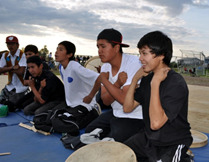
The Dene people (/ˈdɛnɛ/ DE-neh) (dene) are an aboriginal group of First Nations who inhabit the northern boreal and Arctic regions of Canada. The Dene speak Northern Athabaskan languages. Dene is the common Athabaskan word for "people" (Sapir 1915, p. 558). The term "Dene" has two usages. More commonly, it is used narrowly to refer to the Athabaskan speakers of the Northwest Territories and Nunavut in Canada, especially including the Chipewyan (Denesuline), Tlicho (Dogrib), Yellowknives (T'atsaot'ine), Slavey (Deh Gah Got'ine or Deh Cho), and Sahtu (the Eastern group in Jeff Leer's classification; part of the Northwestern Canada group in Keren Rice's classification).
Nakoda First Nation
The Nakoda (also known as Stoney or Îyârhe Nakoda) are an indigenous people in Western Canada and, originally, the United States.

They used to inhabit large parts of Alberta, Saskatchewan, and Montana, but their reserves are now located in Alberta and in Saskatchewan, where they are scarcely differentiated from the Assiniboine. Through their language they are related to the Dakota and Lakota nations of the Great Plains and the Rocky Mountains, part of the large Sioux Nation.They refer to themselves in their own language as "Nakoda", meaning friend, ally.
Ucluelet First Nation.

The Ucluelet First Nation, also known as the Yuułuʔiłʔatḥ (Yuu-thlu-ilth-aht) is the First Nations treaty government of the Yuułuʔiłʔatḥ in the Canadian province of British Columbia, located on the west coast of Vancouver Island on the northwest side of Barkley Sound.
Nipissing First Nation.
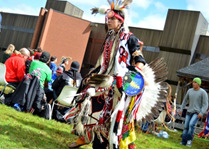
Nipissing first nation 28th annual pow wow 2016.The Nipissing First Nation consists of historic First Nation band governments of Ojibwe and Algonquin descent who, following succeeding cultures of ancestors, have lived in the area of Lake Nipissing in the Canadian province of Ontario for about 9,400 years. They are referred to by many names in European historical records, since the colonists often adopted names given to them by other nations.
Tseshaht First Nation.


My name is Eunice Joe (Tla-ah-shuks). I am Nuu-chah-nulth from the Tseshaht First Nation. My lineage stems from the Tseshaht, Huu-ay-aht and Squamish Nations. My parents are Judy Joe (Dick) and (late) Herbie Joe. My Maternal Grandparents are Thomas Dick from Tseshaht and Veronica Dick (Guss) from Squamish. My Paternal Grandparents are Wilson Joe from Huu-ay-aht and Bella Joe (Watts) from Tseshaht.Tseshaht First Nation is an amalgamation of many tribes up and down Alberni Inlet and in the Alberni Valley of central Vancouver Island in the Canadian province of British Columbia. They are a member of the Nuu-chah-nulth Tribal Council which includes all other Nuu-chah-nulth-aht peoples except the Pacheedaht First Nation.
10 notes
·
View notes
Photo

On two of my visits to the NWT I’ve been a guest on Gwich’in elder William Greenland’s show on CKLB Radio, an indigenous-owned radio station on the edge of old-town Yellowknife broadcasting in Denesuline, Gwich'in, Tlicho, Dehcho and Sahtu Dene dialects as well as welcoming English-speaking guests like myself. Following my last appearance on June 20, 2011, William presented me with an eagle feather. The gift of an eagle feather is a high honour indeed. For that alone I would have been deeply moved but William added even more weight to the gift with his words: “This is an eagle feather that I have carried to First Peoples’ conferences and gatherings around the world and I would like for you to continue its journey with this guitar”. The feather is tethered in the waist of the case bed, always touching the guitar when it’s in the case. I am grateful for the honour William Greenland bestowed on me that day and I hope he feels that the travels we have made are serving the mission he had in mind for us. I cannot open the case and lift out Voyageur without thinking of all of this and I want to say thank you once again. Find out more about the Six String Nation project and book a live or virtual presentation at https://ift.tt/2YY4V7f . . . . . . . #NorthwestTerritories #NWT #Yellowknife #Gwichin #dene #indigenous #TRC #truthandreconciliation #CanadianHistory #cklb #CanEd #CanadianMusic #SocialStudies #CanadianGuitar #acousticguitar #CanadianTeachers #K12 #keynotespeaker #CdnEd #ETFO #EduNWT #caltoncases #OECD #VoiceEd #imaginED #sixstringnation #6SN #williamgreenland #eaglefeather https://instagr.am/p/CGAigJnn6iN/
1 note
·
View note
Text
All want to be understood few wish to understand

The grim truth about the News in Canada is that Canadians,need to know more about about Brexit, what US Congress is up to and what did Dinky Donnie do today, than they do the Indigenous reality in Canada.
Now It’s Election Time in Canada. You'll hear all the Politicians debating the “Major Issues”. You may hear the occasional First Nations, Inuit and Métis “Issues”discussed. The issue will be seen in relation to pipelines and howIndigenous Rights affect business interests. Very little will be said about rights to safe drinking water, decent housing, missing First Nations women, education, healthy diet or even human rights.
We’ll receive news about Human Rights elsewhere, Hong Kong or North Korea. As far as Fires in Brazil it’s all about the environment world wide. Who the fuck do we think live in the burned down world heritage rain forests all worry about? It is their whole world right now and in living color. Their “rights” conflict with business interests, but far less would be said if only the indigenous inhabitants were affected
Try not to be like the Political shills running in this election.Take time to learn what it means to be an “issue”. Don’t set a time limit, keep learning.
In 2016, 1.6 million people identified as Indigenous in Canada. The issues aren't abstract. Start to learn what first nations think their “issues” are. Start to understand by knowing who. Take some time and seek information on your own. Search names, find places, find out about these lives as they are. No need to think you have to understand by Election Day 2019.
Please seek the truth for yourself. Sometimes we need labels to understand. Here is a list of first nations in Canada. Knowledge is the power behind change. Use the internet and libraries. You can even contact band offices for information. Please learn, few understand the First Nations, Inuit and Métis communities of Canada.
The list is not comprehensive, it does provide insight into the indigenous societies, and cultural ties in Canada. Start anywhere and ask questions for yourself.
Abenaki0
Innu (Montagnais-Naskapi)
Oneida
Ahousaht
Interior Salish
Onondaga
Algonquin
Inuinnait (Copper Inuit)
Pacheenaht
Assiniboine
Inuvialuit (Mackenzie Inuit)
Petun
Atikamekw
Kainai (Blood)
Piikani (Peigan)
Baffin Island Inuit
K'asho Got'ine (Hare)
Saldermiut Inuit
Beothuk
Kaska Dena
Sahtu Got'ine (Bearlake)
Blackfoot Confederacy
Kivallirmiut (Caribou Inuit)
Secwepemc (Shuswap)
Cayuga
Ktunaxa (Kootenay)
Sekani
Central Coast Salish
Kwakwaka'wakw (Kwakiutl)
Seneca
Coast Salish
Kyuquot and Checleseht
Shuta Got'ine (Mountain)
Cree
Labradormiut (Labrador Inuit)
Siksika (Blackfoot)
Dakota
Lilwat (Lillooet)
Slavey
Dakelh (Carrier)
Lingit (Tlingit)
Stoney-Nakoda
Dane-zaa (Beaver)
Métis
Syilx (Okanagan)
Dene
Mi'kmaq
Tagish
Denesuline (Chipewyan)
Mohawk
Tahltan
Ditidaht
Mowachaht-Muchalaht
Tla-o-qui-aht (Clayoquot)
Ehattesaht
Nahani
Tlicho (Dogrib)
Gitxsan (Gitksan)
Netsilingmiut (Netsilik Inuit)
Toquaht
Gwich'in
Neutral Confederacy
Tr'ondëk Hwëch'in (Han)
Haida
Nicola-Similkameen
Tseshaht (Sheshaht)
Haisla (Kitamaat)
Nisga'a
Tsilhqot'in (Chilcotin)
Haudenosaunee (Six Nations or Iroquois)
Nlaka'pamux (Thompson)
Tsimshian
Heiltsuk
Northern Georgia Strait Coast Salish
Tsuut'ina (Sarcee)
Hesquiaht
Nuchatlaht
Tutchone
Hupacasath (Opetchesaht)
Nunavimmiut (Ungava Inuit)
Uchucklesaht
Huu-ay-aht
Nuu-chah-nulth
Ucluelet (First Nation)
Huron-Wendat
Nuxalk (Bella Coola)
Wolastoqiyik (Maliseet)
Iglulingmuit (Iglulik Inuit)
Odawa
Wetal (Tsetsaut)
Inuit
Ojibwa
Yellowknives (band)

13 notes
·
View notes
Text
Linguistic Diversity Challenge Day Two: North Slavey
Basic Facts:
North Slavey, also called Dené or Slavi, is spoken by the Slavey and Sahtu peoples in Canada, and is a member of the Athabaskan language family. It has official status in Canada’s Northwest Territories. There are three main dialects: K’áshogot’ıné, Sahtúgot’ıné, and Shıhgot’ıne. In total, the language has around 800 native speakers.
Writing System:
North Slavey is written using a modified Latin alphabet, or a syllabic script developed for the K’áshogot’ıné dialect in 1911. When written in the Latin alphabet, high tones are marked with an accent while low tones are unmarked.
How does it sound?
Slavey has two tones, high and low. The consonant inventory differs considerably between the different dialects, but most have 6 vowels. Many types of syllabic structures are allowed.
Grammatical features:
Slavey has an extensive system of verb prefixing, where prefixes must be attached to a stem in a very specific order. It has three genders which are marked through prefixing or lack thereof, and marks 1st, 2nd, 3rd, and 4th person. I find its system of noun classification, which is organized by animacy, dimensions, rigidity, and shape, among other things, incredibly interesting. It has two aspects: perfective and imperfective. Its only proper tense is a future tense, with other tenses being marked periphrastically. Basic word order is SOV.
Resources to learn more about Slavey:
http://www.native-languages.org/slavey.htm
http://www.language-archives.org/language/scs
http://www.languagegeek.com/dene/kashogotine/north_slavey.html
17 notes
·
View notes
Link
How i spend my evening. :)
#starfish works for the government of canada#and sometimes gets to do cool things#like stream on a minister's channel#and witness history#then eat cake
1 note
·
View note
Text
Sahtu Dene documentarian journeys 17,000 km for Indigenous storytelling project
Sahtu Dene documentarian journeys 17,000 km for Indigenous storytelling project
At 27, Tate Juniper is stepping into his journalist boots for the first time, travelling 17,000 km across the United States by road, capturing stories and portraits of Indigenous people through his new project We Are The First.
An electrician and accountant by trade, Juniper started the project because “Indigenous representation in popular culture and media has been historically and in the…

View On WordPress
1 note
·
View note
Text
Events 4.9
190 – Dong Zhuo has his troops evacuate the capital Luoyang and burn it to the ground.
475 – Byzantine Emperor Basiliscus issues a circular letter (Enkyklikon) to the bishops of his empire, supporting the Monophysite christological position.
537 – Siege of Rome: The Byzantine general Belisarius receives his promised reinforcements, 1,600 cavalry, mostly of Hunnic or Slavic origin and expert bowmen. He starts, despite shortages, raids against the Gothic camps and Vitiges is forced into a stalemate.
1241 – Battle of Liegnitz: Mongol forces defeat the Polish and German armies.
1288 – Mongol invasions of Vietnam: Yuan forces are defeated by Trần forces in the Battle of Bach Dang in present-day northern Vietnam.
1388 – Despite being outnumbered 16 to 1, forces of the Old Swiss Confederacy are victorious over the Archduchy of Austria in the Battle of Näfels.
1454 – The Treaty of Lodi is signed, establishing a balance of power among northern Italian city-states for almost 50 years.
1609 – Eighty Years' War: Spain and the Dutch Republic sign the Treaty of Antwerp to initiate twelve years of truce.
1609 – Philip III of Spain issues the decree of the "Expulsion of the Moriscos".
1682 – Robert Cavelier de La Salle discovers the mouth of the Mississippi River, claims it for France and names it Louisiana.
1784 – The Treaty of Paris, ratified by the United States Congress on January 14, 1784, is ratified by King George III of the Kingdom of Great Britain, ending the American Revolutionary War. Copies of the ratified documents are exchanged on May 12, 1784.
1860 – On his phonautograph machine, Édouard-Léon Scott de Martinville makes the oldest known recording of an audible human voice.
1865 – American Civil War: Robert E. Lee surrenders the Army of Northern Virginia (26,765 troops) to Ulysses S. Grant at Appomattox Court House, Virginia, effectively ending the war.
1909 – The U.S. Congress passes the Payne–Aldrich Tariff Act.
1914 – Mexican Revolution: One of the world's first naval/air skirmishes takes place off the coast of western Mexico.
1917 – World War I: The Battle of Arras: The battle begins with Canadian Corps executing a massive assault on Vimy Ridge.
1918 – World War I: The Battle of the Lys: The Portuguese Expeditionary Corps is crushed by the German forces during what is called the Spring Offensive on the Belgian region of Flanders.
1937 – The Kamikaze arrives at Croydon Airport in London. It is the first Japanese-built aircraft to fly to Europe.
1939 – African-American singer Marian Anderson gives a concert at the Lincoln Memorial after being denied the use of Constitution Hall by the Daughters of the American Revolution.
1940 – World War II: Operation Weserübung: Germany invades Denmark and Norway.
1940 – Vidkun Quisling seizes power in Norway.
1942 – World War II: The Battle of Bataan ends. An Indian Ocean raid by Japan's 1st Air Fleet sinks the British aircraft carrier HMS Hermes and the Australian destroyer HMAS Vampire.
1945 – Execution of Dietrich Bonhoeffer, anti-Nazi dissident and spy, by the Nazi regime.
1945 – World War II: The German heavy cruiser Admiral Scheer is sunk by the Royal Air Force.
1945 – World War II: The Battle of Königsberg, in East Prussia, ends.
1945 – The United States Atomic Energy Commission is formed.
1947 – The Glazier–Higgins–Woodward tornadoes kill 181 and injure 970 in Texas, Oklahoma, and Kansas.
1947 – The Journey of Reconciliation, the first interracial Freedom Ride begins through the upper South in violation of Jim Crow laws. The riders wanted enforcement of the United States Supreme Court's 1946 Irene Morgan decision that banned racial segregation in interstate travel.
1947 – United Nations Security Council Resolution 22 relating to Corfu Channel incident is adopted.
1948 – Jorge Eliécer Gaitán's assassination provokes a violent riot in Bogotá (the Bogotazo), and a further ten years of violence in Colombia.
1948 – Fighters from the Irgun and Lehi Zionist paramilitary groups attacked Deir Yassin near Jerusalem, killing over 100.
1952 – Hugo Ballivián's government is overthrown by the Bolivian National Revolution, starting a period of agrarian reform, universal suffrage and the nationalization of tin mines
1957 – The Suez Canal in Egypt is cleared and opens to shipping following the Suez Crisis.
1959 – Project Mercury: NASA announces the selection of the United States' first seven astronauts, whom the news media quickly dub the "Mercury Seven".
1960 – Dr. Hendrik Verwoerd, Prime Minister of South Africa and architect of apartheid, narrowly survives an assassination attempt by a white farmer, David Pratt in Johannesburg.
1967 – The first Boeing 737 (a 100 series) makes its maiden flight.
1969 – The first British-built Concorde 002 makes its maiden flight from Filton to RAF Fairford.
1980 – The Iraqi regime of Saddam Hussein kills philosopher Muhammad Baqir al-Sadr and his sister Bint al-Huda after three days of torture.
1981 – The U.S. Navy nuclear submarine USS George Washington accidentally collides with the Nissho Maru, a Japanese cargo ship, sinking it and killing two Japanese sailors.
1989 – Tbilisi massacre: An anti-Soviet peaceful demonstration and hunger strike in Tbilisi, demanding restoration of Georgian independence, is dispersed by the Soviet Army, resulting in 20 deaths and hundreds of injuries.
1990 – An IRA bombing in County Down, Northern Ireland, kills three members of the UDR.
1990 – The Sahtu Dene and Metis Comprehensive Land Claim Agreement is signed for 180,000 square kilometres (69,000 sq mi) in the Mackenzie Valley of the western Arctic.
1991 – Georgia declares independence from the Soviet Union.
1992 – A U.S. Federal Court finds former Panamanian dictator Manuel Noriega guilty of drug and racketeering charges. He is sentenced to 30 years in prison.
2003 – Iraq War: Baghdad falls to American forces.
2009 – In Tbilisi, Georgia, up to 60,000 people protest against the government of Mikheil Saakashvili.
2013 – A 6.1–magnitude earthquake strikes Iran killing 32 people and injuring over 850 people.
2013 – At least 13 people are killed and another three injured after a man goes on a spree shooting in the Serbian village of Velika Ivanča.
2014 – A student stabs 20 people at Franklin Regional High School in Murrysville, Pennsylvania.
2017 – The Palm Sunday church bombings at Coptic churches in Tanta and Alexandria, Egypt, take place.
2017 – After refusing to give up his seat on an overbooked United Express flight, Dr. David Dao Duy Anh is forcibly dragged off the flight by aviation security officers, leading to major criticism of United Airlines.
0 notes
Text
Day 24 & 25: September 9 & 10
Quarantine Diaries: 11 & 12
Yesterday was kind of a slower paced day. We got some laundry, unpacking, and organizing done but mostly played and snuggled with the girls!
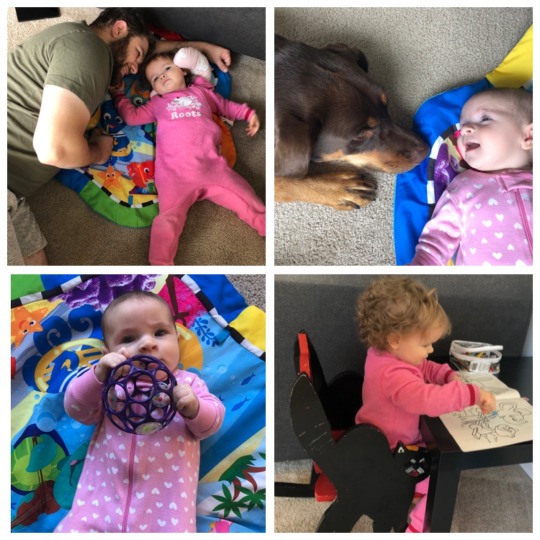
Grover was busy completing his online dating profile, so he didn’t spend a lot of time with us.

Claire was very snuggly today. Hoping this “developmental leap” crankiness passes quickly!

Today we worked on setting up Claire’s future room and unpacking more of Annabelle’s boxes. I’m hoping the paint gets here soon. I am so excited to paint and put the bed together. Annabelle is going to be so excited when she sees it!
We decided to take a break from the house. We went to “Old Town” to visit the Pilot Monument and take in the beautiful 360-degree-views of Back Bay, houseboats, the floatplane aerodrome and the downtown skyline - our new home!

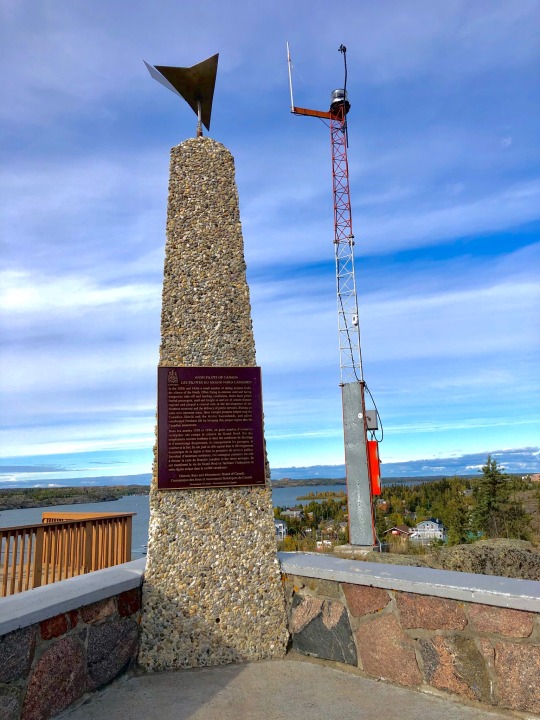
It is dedicated to the bush pilots and engineers whose lives were lost as they flew the wilderness skies of the Northwest Territories. The monument also serves a practical purpose: When the light on the tower is flashing, it lets residents and visitors know that floatplanes or skiplanes are active on Yellowknife Bay.

The view was absolutely beautiful!
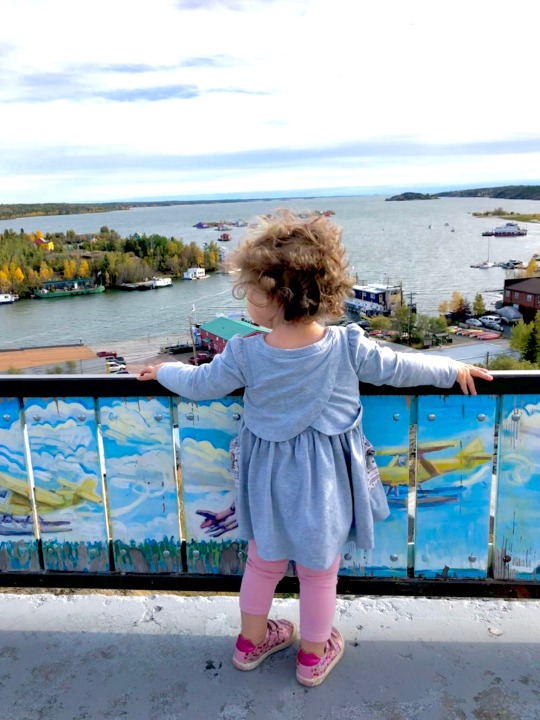

We are going back to “Old Town” this weekend so we can explore more! The quick glimpse we saw today - we really liked it!
Isolation Fact #10:
The Northwest Territories is home to 42,000 people as of the 2016 census – barely one-thousandth of the Canadian population. Half of the population is Indigenous – here since time immemorial – while half come from elsewhere. Of the former, a wide range of cultures are represented. About nine percent are Métis, mostly concentrated on the south side of Great Slave Lake. Another 11 percent are Inuvialuit, the people of the far North. The Dene make up about 30 percent of the territorial population. And among those 13,000 or so Dene, there are five main groups: The Chipewyan around Lutselk'e on the East Arm of Great Slave Lake, the Tłįchǫ up in the North Slave region communities near Behchoko and Whati, The Yellowknives who are north and northeast of Great Slave Lake, the Slavey -- North Slavey live around the Deh Cho region and the South Slavey around the southwest of Great Slave Lake in communities like Fort Providence and Hay River, and the Sahtu Dene in the communities around Great Bear Lake.
0 notes
Text
Tuesday, March 14, 2107 Canadian TV Listings (Times Eastern)
And Welcome to Day Three!
Yesterday, we took the D train, visited Central Park and it’s endless supply of climbable rocks, statues and lookout towers. We had a hot dog from a cart, which was proclaimed “not very good and too small.” We went to a Duane Reade and purchased an item not available in Canada.
We walked down Broadway to Times Square. On the way, I did see the Ed Sullivan Theater (!) and purchased a t-shirt at the Hello, Deli (!!) from the one and only Rupert Gee (!!!). We did hit the M&M Store, which greatly pleased my 8 year old.
For dinner we went to Juniors, which was delicious and had amazing cheesecake.
As for today’s snow, it looks doable, but very windy. Wish me luck!
And now...
WHERE CAN I FIND THOSE PREMIERES?:
TRIAL & ERROR (CTV) 10:00pm/10:30pm
ADAM CAROLLA AND FRIENDS BUILD STUFF LIVE (SPIKE CANADA) 10:00pm
NHL HOCKEY
(SNPACIFIC) 7:00pm: Wild at Capitals
(TSN3) 7:00pm: Jets at Devils
(TSN4) 7:30pm: Leafs at Panthers
(TSN5) 7:30pm: Lightning at Sens
(SNEAST) 7:30pm: Blackhawks at Habs
(SNWEST) 9:00pm: Stars at Oilers
DENE: A JOURNEY (APTN) 7:00pm: Eugene returns to Tulita for a visit and a chance to go hunting with his uncles in the Sahtu Mountains.
SONGS SHE WROTE ABOUT PEOPLE SHE KNOWS (SUPER CHANNEL 03) 8:00pm: Carol, an emotionally repressed woman, loses friends and alienates people when she begins singing songs she wrote about people she knows. But she unexpectedly inspires her boss, to whom she dedicates the song Asshole Dave, to attempt to reignite his dream of becoming a rock star.
RICK MERCER REPORT (CBC) 8:00pm: Rick tries out a self-driving car; Rick attends the annual Griz Days winter festival in Fernie, B.C.
THIS HOUR HAS 22 MINUTES (CBC) 8:30pm: Melania Trump reads ``Oh the Places You'll Go''; Michelle Rempel wears her sommelier hat; the Newfoundland and Labrador curling team; another Anne of Green Gables reboot.
FIRST DATES (SLICE) 8:00pm/8:30pm
SCHITT’S CREEK (CBC) 9:00pm: David's ex comes to town to do a photoshoot for Moira; Johnny and Roland think Bob is cheating at poker.
WORKIN’ MOMS (CBC) 9:30pm: Kate tries to make up for her upcoming time away; Anne tries to bond with Alice; Frankie crosses a line with a buyer.
THE REAL HOUSEWIVES OF TORONTO (SLICE) 10:00pm
WHL HOCKEY (SN360/SNPACIFIC) 10:00pm: Victoria Royals at Vancouver Giants
A PLACE TO CALL HOME (BBC CANADA) 10:00pm: Anna presents Elizabeth with her manuscript.
JADE FEVER (DISCOVERY CANADA) 10:00pm/10:30pm: The Bunces set up a new mining camp in hopes of impressing their urbanite business partners; tempers soar when Claudia and Robin clash with their son Josh while unloading some platforms. In Episode Two, the first boulder of the season proves challenging to get back to camp; once the Bunces and their crew finally get it there, Claudia and her new partners disagree on the best way to cut it.
#rick mercer report#22 minutes#this hour has 22 minutes#first dates#schitt's creek#workin' moms#real housewives of toronto#a place to call home#jade fever#NHL Hockey#whl
3 notes
·
View notes
Text
CKLB NEWS -
Members of Lutsel K'e Dene First Nation (LKDFN) are one step more detailed to getting Thaidene Nëné National forest.
Last week, they licensed Chief and Council to hold a vote to authorize the contracts between Lutsel K'e, the Federal government of Canada and the Federal Government of the Northwest Territories.
"Our company believe that the most progressive relationship between Crown federal governments and Native governments is the articulation of the spirit and intent into which we entered Treaty 8," states Steven Nitah, LKDFN's head negotiator. "We consented to share the lands and resources, to handle them together and to take advantage of them together."
All qualified LKDFN members will have the ability to vote on February 18, with an advance survey on February 11. Presuming it results in support for the arrangements, Nitah said the neighborhood will line up a finalizing event with the other 2 parties.
For its part, the Department of Environment and Natural Resources (ENR) is working to introduce draft legislation in the February-March session of the Legislative Assembly to permit for the development of the park.
"Prior to the enactment of any legislation, the GNWT will guarantee that its consultation obligations with Native federal governments and organizations are fulfilled," wrote ENR spokesperson Meagan Wohlberg in an e-mail.
She included that the legislation is "designed to be flexible" as it would be the blueprint to develop other possible protection locations like Dinàgà Wek'èhodì (North Arm of Great Slave Lake) and Ts'ude niline Tu'eyeta (Ramparts wetlands in the Sahtu).
Long-time coming
The park would secure about 33,500 square kilometres around the eastern arm of Great Slake Lake.
In the late 1960s, the Government of Canada proposed a security area because region, but it was refused by Lutsel K'e at the time.
"Canada was right in the midst of their assimilation policy," says Nitah. "National parks was among the tools they utilized to exercise that policy ... They 'd require Native people off their territory, burn their houses and they weren't allowed back."
Now 50 years later on, Nitah states the relationship has actually altered.
While the vote and territorial legislation are still technically unknowns, if all goes according to prepare the park could be developed as quickly as July.
Nitah wishes to see it done by August "at the most recent."
Asked if he was pleased the procedure is coming to and end, he said, "It's towards completion of negotiations but the beginning of a brand-new relationship."
0 notes